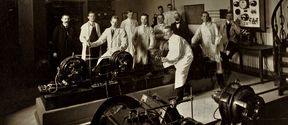In the 19th century, military technology research and education were in many countries directly linked to the higher education system. In the United States, for example, military education was an essential part of the curriculum of many universities. In France, military technology education was given in dedicated universities, which students applied for after completing basic technology studies. In German-speaking countries, military-technological research was conducted after the 1890s in state research institutes and education in the field was thus connected with higher education.
During 1809–1917 – Finland's period of autonomy – military technical education and research had been organised chiefly within the education and research systems of the Russian Empire. Finnish officers who served in the more technology-minded branches of the military, such as artillery officer Vilho Petter Nenonen, were trained at military educational institutions in St. Petersburg and Moscow.
During the First World War, Finnish pro-independence youths travelled to Germany to receive military training in anticipation of an independence struggle. In the Finnish Civil War, German-trained Jaegers formed the body of the field officer corps of the White army, but the commander-in-chief also appointed former officers of Imperial Russia to senior positions in the army. After the war, several Finnish officers left for further training in France, England and Italy. Many Finnish Air Force officers were trained in France, while naval officers were mainly trained in Italy.
Two views emerged on how education should be organised in the technical branches of the military. To clarify the situation, engineer Hugo Nybergh drafted a proposal to name the first part of the diploma awarded by the Helsinki University of Technology Department of Engineering a bachelor's degree in polytechnics, following the example of the French system. The debate was again settled by resource shortages, mainly the lack of teachers. It was considerably cheaper to send a few Finnish military technology students to the French Division Technique du Génie and the École Supérieure de Guerre, for example.
French officers also came to Finland: In the 1920s, responsibility for fortifying the Karelian Isthmus was given to Lieutenant Colonel J. J. Gros-Coissy, for example.
After the idea of a specialised Finnish military-technical school was abandoned, the decision was made to provide basic technical training for Finnish officers through courses organised in co-operation between the Finnish Defense Forces and the Helsinki University of Technology. Funding for the training was obtained via Vilho Petter Nenonen, then serving as artillery inspector.
Technical courses for officers began in the autumn semester of 1923. Twenty officers were seconded to study at the Helsinki University of Technology.
Helsinki University of Technology was tasked with providing basic courses in mathematics, science and technology for officers serving in the technical branches, complementing the military science education provided by the War College, founded in 1923. During the 1920s, a little over a dozen officers were seconded to the Helsinki University of Technology every year. The War College solidified its university status in 1930; in 1993, it would be merged into the National Defence University. After 1933, officers were no longer separately assigned to study at Helsinki University of Technology.
Training the engineer reserves
In connection with the establishment of the War College, discussion arose concerning the training of a reserve of technical personnel key to national defense . A committee was set up in 1924 to consider measures for creating an adequate reserve of engineers. The committee consisted of representatives of the army's technical staff and the Finnish Association of Engineers, which had been established the previous year to represent the interests of university-educated engineers. On 25 March 1925, the President of Finland approved the committee's proposal for provisions for the training of reserve engineer officers.
The system was based on the provision of additional training for those in the military reserve who an education in civil engineering or another field of technology. Their military assignments would be made according wartime needs, and military maintenance issues were already tied, at least in principle, to peacetime civilian production. Engineers and architects working in civilian sectors could be appointed as engineer lieutenants after completing a reserve technical officer's degree at the Cadet School. To emphasise the importance of technical training, the rank scale for technical officers began at lieutenant instead of sub-lieutenant, as was the case for regular officers.
The Cadet School inaugurated the first technical officers' course in 1927, with more than 80 engineers and architects attending. In the spring of 1928, 104 officers graduated from the second course.
The direct connection between military technological education and the Helsinki University of Technology was finally severed in 1965, when the teachers' council decided that admission points would no longer be awarded for reserve officer training and participating in the activities of the technical branches of the military when applying to study at HUT.
